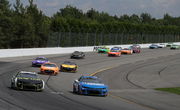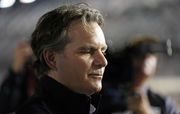
via Imago
CHARLOTTE, NC – MAY 26: Christopher Bell 20 Joe Gibbs Racing Rheem Toyota and Chase Briscoe 14 Stewart Haas Racing Mahindra Compact Tractors Ford look on prior to the running of the NASCAR, Motorsport, USA Cup Series Coca-Cola 600 on May 26, 2024, at Charlotte Motor Speedway in Concord, NC. Photo by Jeffrey Vest/Icon Sportswire AUTO: MAY 26 NASCAR Cup Series Coca-Cola 600 EDITORIAL USE ONLY Icon240526637

via Imago
CHARLOTTE, NC – MAY 26: Christopher Bell 20 Joe Gibbs Racing Rheem Toyota and Chase Briscoe 14 Stewart Haas Racing Mahindra Compact Tractors Ford look on prior to the running of the NASCAR, Motorsport, USA Cup Series Coca-Cola 600 on May 26, 2024, at Charlotte Motor Speedway in Concord, NC. Photo by Jeffrey Vest/Icon Sportswire AUTO: MAY 26 NASCAR Cup Series Coca-Cola 600 EDITORIAL USE ONLY Icon240526637
In NASCAR, sponsorship is the lifeblood of the sport. Weaving together the financial, technical, and operational aspects that fuel race teams. From car designs to travel logistics, the sport thrives on the backing of corporate partnerships. However, a recent revelation by Joe Gibbs Racing (JGR) media strategist Reece Kennedy has sparked intrigue about how sponsorship funds are distributed in multi-car organizations.
While sponsorships often get attention for their flashy paint schemes and high-profile logos, their behind-the-scenes impact on team dynamics is frequently underappreciated. Kennedy’s explanation sheds light on JGR’s approach, where the focus is teamwork over individual interests. But how does this system work in practice, and what does it reveal about NASCAR’s evolving sponsorship landscape?
ADVERTISEMENT
Article continues below this ad
How sponsorship fuels JGR’s team-first philosophy
In a video FAQ session posted on the Joe Gibbs Racing Instagram account, Reece Kennedy broke down a key aspect of sponsorship management at JGR. His comments offered a rare look at the financial strategy behind one of NASCAR’s most successful multi-car organizations.
“How is the money distributed within a team when a sponsor sponsors just one car but there’s a multi-car organization?” Kennedy repeated the question before delving into the answer.
“It’s pretty simple,” he said. “At Joe Gibbs Racing, we’re four cars, one team. So, all the money goes into our overall operating budget. Expenses and everything are divvied up evenly among all the teams, regardless of how much a sponsor pays or a particular driver makes—it all goes into one bucket, and we do everything as a team. So nothing is segmented per team as far as finances go.” This puts into perspective how devastating a loss FedEx leaving Denny Hamlin could be for JGR as a team, as they were one of the largest sponsors. The financial impact of sponsors could also be seen in 2022 when then-JGR driver Kyle Busch lost his 15-year-long M&M and Mars sponsorship. Busch consequently parted ways with JGR, presumably because they weren’t able to find a sponsor for his pay grade.
Speaking on his exit to Jordan Bianchi in 2024, Busch said, “Did JGR try hard enough to sell me? My answer to that is no,” Busch said to Bianchi.”[Instead] they offered me a contract to race there and they weren’t going to have sponsorship on the car, but I didn’t feel like that was fair for the 15 years that I was there; I didn’t want Joe [Gibbs] putting his own money into the program.” Busch added. Busch joined Richard Childress Racing from JGR in 2022 after realizing he would be driving without a sponsor.
View this post on Instagram
What’s your perspective on:
With FedEx and Mars gone, can JGR maintain its competitive edge without these major sponsors?
Have an interesting take?
This “one team, one bucket” approach highlights JGR’s commitment to fostering collaboration over competition within the organization. It ensures that each of its four full-time Cup Series drivers—Denny Hamlin, Christopher Bell, Ty Gibbs, and newcomer Chase Briscoe—have access to equal resources, regardless of individual sponsorship deals.
The unified system also emphasizes a broader operational philosophy: teamwork leads to success on the track. Joe Gibbs Racing’s collaborative model has been instrumental in its consistent performances over the years, including multiple championships. However, this team-first approach faces challenges as major sponsors like FedEx and Mars have exited the sport in recent years, impacting JGR’s revenue streams.
Trending
The true impact of sponsorship on teams
Sponsorship isn’t just about car decals or fire suit logos—it’s a financial lifeline that keeps teams afloat in the high-stakes world of NASCAR. Industry estimates suggest that sponsorships account for 60-80% of team revenues. Historically, full-season deals ranged from $25-30 million per car, but in today’s landscape, those figures have dropped to $10-20 million annually.
For JGR, sponsorships play a vital role in maintaining its competitiveness. Despite losing FedEx as the long-time sponsor of Denny Hamlin’s No. 11 Toyota and Mars after Kyle Busch’s departure, the team has locked in key partners like Monster Energy, Interstate Batteries, and Bass Pro Shops for 2025. These deals not only fund race operations but also enable the team to invest in technology, safety, and performance enhancements.
This shift in sponsorship dynamics mirrors a broader trend across NASCAR. Many companies now prefer technical alliances over traditional check-writing deals. For instance, Legacy Motor Club’s partnership with D3O provides driver safety and comfort solutions while giving the sponsor brand exposure. Similarly, JGR and other top teams have embraced collaborative partnerships that integrate sponsors into their operational frameworks.
“Sponsorships have evolved beyond logos—they’re now about bringing tangible value to teams,” said Joey Cohen, VP of Race Operations at Legacy Motor Club. “It’s a win-win scenario. Teams gain performance advantages, and sponsors get exposure and innovation.”
ADVERTISEMENT
Article continues below this ad
Jimmie Johnson, co-owner of Legacy, reflected on how sponsorships have come full circle. “In the sixties and seventies, partnerships were about testing new technologies,” he said. “Now we’re back to being a test bed for innovation—only the technologies are different.”
These partnerships also create ripple effects for drivers, who benefit directly from improved safety measures and indirectly from greater financial stability within their teams. From reduced driver fatigue to confidence in safety features, such sponsorships enable drivers to push their limits on the track.
Meanwhile, top-tier sponsors like Coca-Cola, McDonald’s, and Busch Beer support other powerhouse teams, including Trackhouse Racing and 23XI Racing. These partnerships help diversify the sponsorship ecosystem, ensuring the sustainability of the sport amid changing market dynamics.
ADVERTISEMENT
Article continues below this ad
For JGR, the departure of major sponsors has undoubtedly been a setback, but its “nothing is segmented” philosophy ensures that all four cars remain competitive, regardless of individual deals. Sponsorship isn’t just a financial arrangement in NASCAR—it’s the backbone of a complex ecosystem that balances innovation, safety, and competition.
ADVERTISEMENT
ADVERTISEMENT
ADVERTISEMENT
ADVERTISEMENT







With FedEx and Mars gone, can JGR maintain its competitive edge without these major sponsors?